Air Transport Economics: Growth Determinants and Government Steps
VerifiedAdded on 2023/01/12
|10
|1920
|37
Report
AI Summary
This report provides a detailed analysis of the air transport economics within the UK aviation industry. It begins by examining the macroeconomic factors influencing the industry, including political, economic, social, technological, legal, and environmental factors, using a PESTLE analysis to highlight key impacts such as Brexit, strikes, and technological advancements. The report then delves into the major challenges faced by the industry, such as infrastructure capacity shortfalls, regulatory changes, and the need for digital transformation and improved customer experience. Furthermore, the report identifies key determinants of growth, including financial performance metrics and regulatory costs. Finally, it suggests steps the government could take to support the industry, focusing on areas like passenger experience, innovation, and sustainability, offering insights into how the UK can navigate the current economic and regulatory landscape to foster sustainable growth and address critical challenges. The report references multiple sources, including academic journals and industry reports.
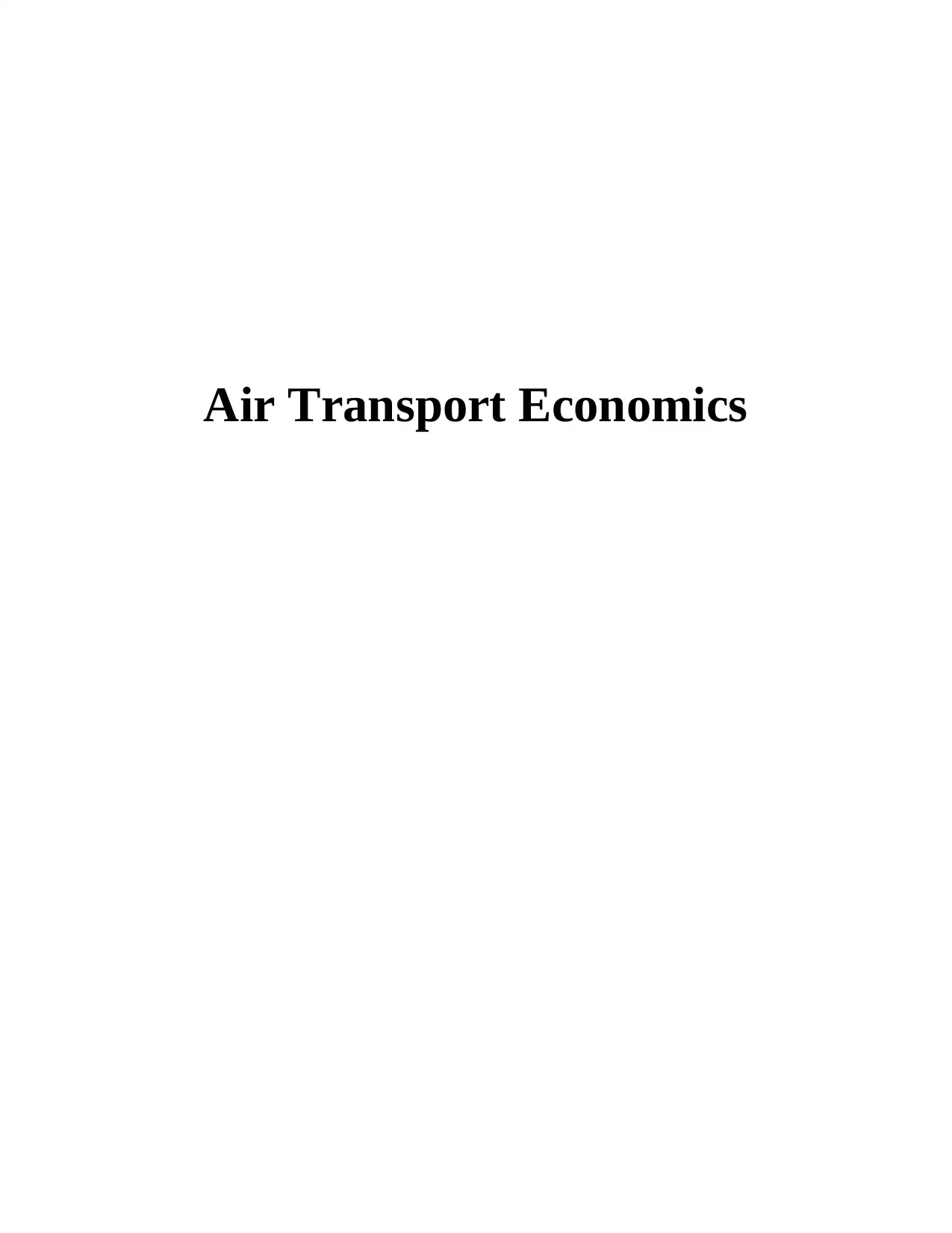
Air Transport Economics
Paraphrase This Document
Need a fresh take? Get an instant paraphrase of this document with our AI Paraphraser
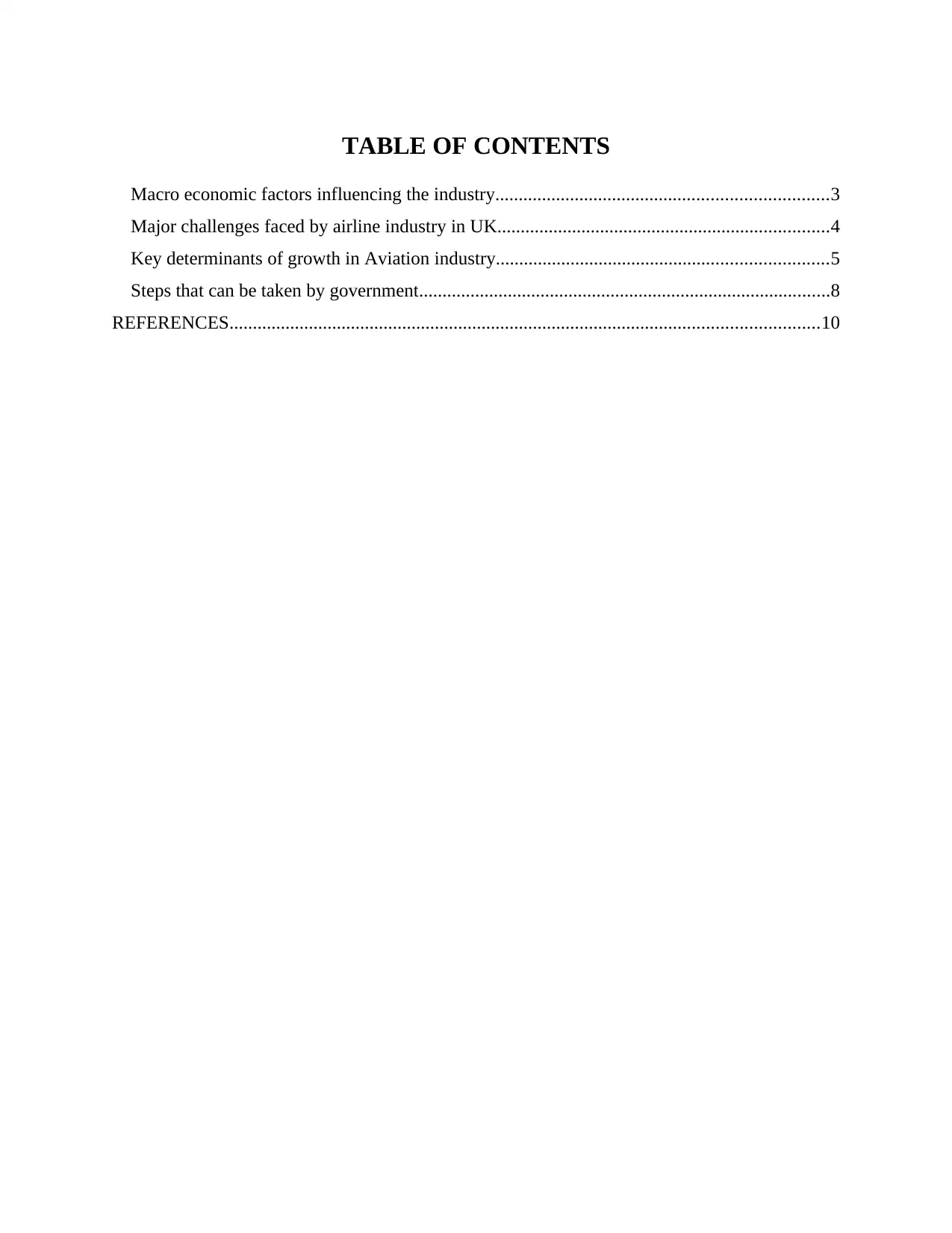
TABLE OF CONTENTS
Macro economic factors influencing the industry.......................................................................3
Major challenges faced by airline industry in UK.......................................................................4
Key determinants of growth in Aviation industry.......................................................................5
Steps that can be taken by government........................................................................................8
REFERENCES..............................................................................................................................10
Macro economic factors influencing the industry.......................................................................3
Major challenges faced by airline industry in UK.......................................................................4
Key determinants of growth in Aviation industry.......................................................................5
Steps that can be taken by government........................................................................................8
REFERENCES..............................................................................................................................10
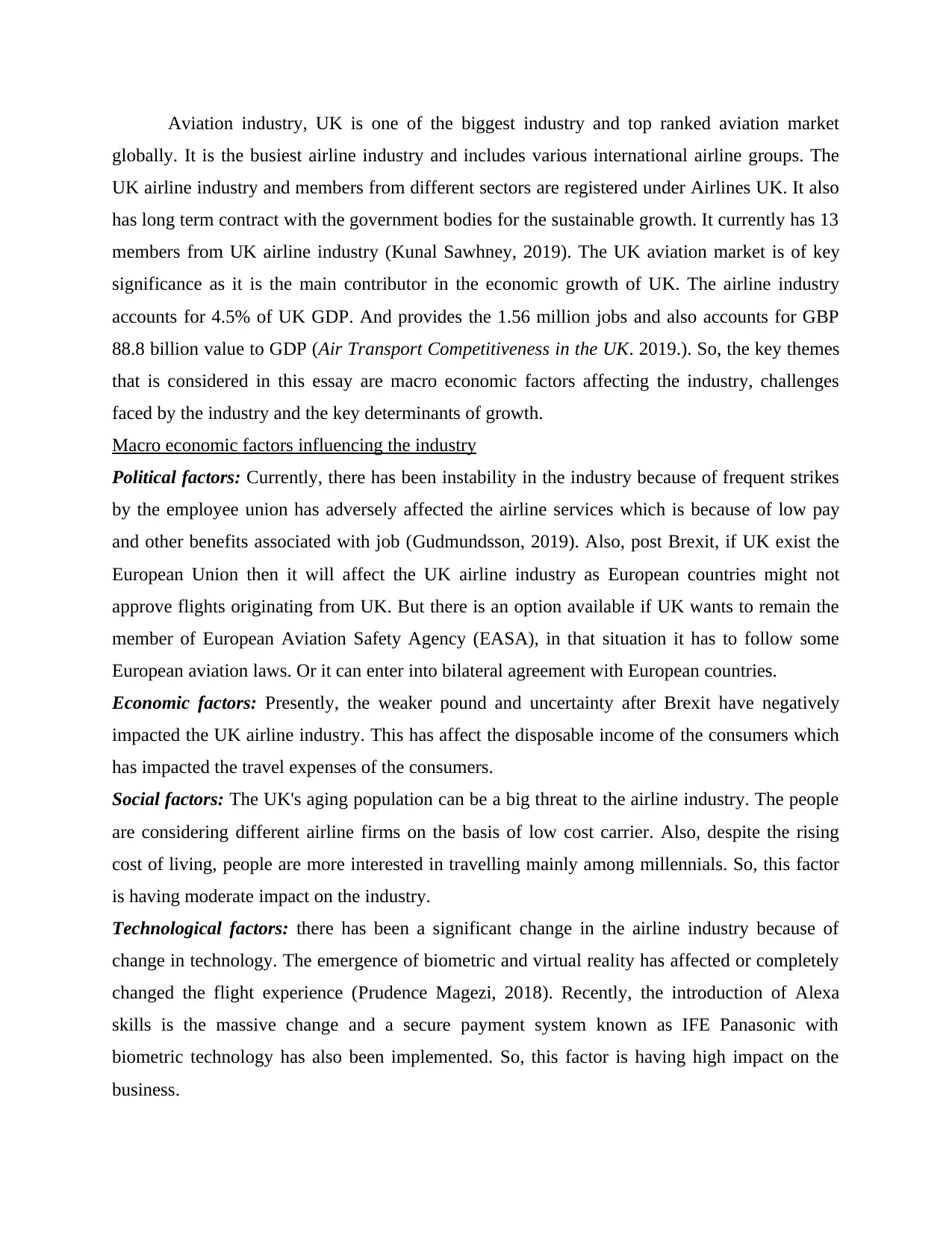
Aviation industry, UK is one of the biggest industry and top ranked aviation market
globally. It is the busiest airline industry and includes various international airline groups. The
UK airline industry and members from different sectors are registered under Airlines UK. It also
has long term contract with the government bodies for the sustainable growth. It currently has 13
members from UK airline industry (Kunal Sawhney, 2019). The UK aviation market is of key
significance as it is the main contributor in the economic growth of UK. The airline industry
accounts for 4.5% of UK GDP. And provides the 1.56 million jobs and also accounts for GBP
88.8 billion value to GDP (Air Transport Competitiveness in the UK. 2019.). So, the key themes
that is considered in this essay are macro economic factors affecting the industry, challenges
faced by the industry and the key determinants of growth.
Macro economic factors influencing the industry
Political factors: Currently, there has been instability in the industry because of frequent strikes
by the employee union has adversely affected the airline services which is because of low pay
and other benefits associated with job (Gudmundsson, 2019). Also, post Brexit, if UK exist the
European Union then it will affect the UK airline industry as European countries might not
approve flights originating from UK. But there is an option available if UK wants to remain the
member of European Aviation Safety Agency (EASA), in that situation it has to follow some
European aviation laws. Or it can enter into bilateral agreement with European countries.
Economic factors: Presently, the weaker pound and uncertainty after Brexit have negatively
impacted the UK airline industry. This has affect the disposable income of the consumers which
has impacted the travel expenses of the consumers.
Social factors: The UK's aging population can be a big threat to the airline industry. The people
are considering different airline firms on the basis of low cost carrier. Also, despite the rising
cost of living, people are more interested in travelling mainly among millennials. So, this factor
is having moderate impact on the industry.
Technological factors: there has been a significant change in the airline industry because of
change in technology. The emergence of biometric and virtual reality has affected or completely
changed the flight experience (Prudence Magezi, 2018). Recently, the introduction of Alexa
skills is the massive change and a secure payment system known as IFE Panasonic with
biometric technology has also been implemented. So, this factor is having high impact on the
business.
globally. It is the busiest airline industry and includes various international airline groups. The
UK airline industry and members from different sectors are registered under Airlines UK. It also
has long term contract with the government bodies for the sustainable growth. It currently has 13
members from UK airline industry (Kunal Sawhney, 2019). The UK aviation market is of key
significance as it is the main contributor in the economic growth of UK. The airline industry
accounts for 4.5% of UK GDP. And provides the 1.56 million jobs and also accounts for GBP
88.8 billion value to GDP (Air Transport Competitiveness in the UK. 2019.). So, the key themes
that is considered in this essay are macro economic factors affecting the industry, challenges
faced by the industry and the key determinants of growth.
Macro economic factors influencing the industry
Political factors: Currently, there has been instability in the industry because of frequent strikes
by the employee union has adversely affected the airline services which is because of low pay
and other benefits associated with job (Gudmundsson, 2019). Also, post Brexit, if UK exist the
European Union then it will affect the UK airline industry as European countries might not
approve flights originating from UK. But there is an option available if UK wants to remain the
member of European Aviation Safety Agency (EASA), in that situation it has to follow some
European aviation laws. Or it can enter into bilateral agreement with European countries.
Economic factors: Presently, the weaker pound and uncertainty after Brexit have negatively
impacted the UK airline industry. This has affect the disposable income of the consumers which
has impacted the travel expenses of the consumers.
Social factors: The UK's aging population can be a big threat to the airline industry. The people
are considering different airline firms on the basis of low cost carrier. Also, despite the rising
cost of living, people are more interested in travelling mainly among millennials. So, this factor
is having moderate impact on the industry.
Technological factors: there has been a significant change in the airline industry because of
change in technology. The emergence of biometric and virtual reality has affected or completely
changed the flight experience (Prudence Magezi, 2018). Recently, the introduction of Alexa
skills is the massive change and a secure payment system known as IFE Panasonic with
biometric technology has also been implemented. So, this factor is having high impact on the
business.
⊘ This is a preview!⊘
Do you want full access?
Subscribe today to unlock all pages.

Trusted by 1+ million students worldwide
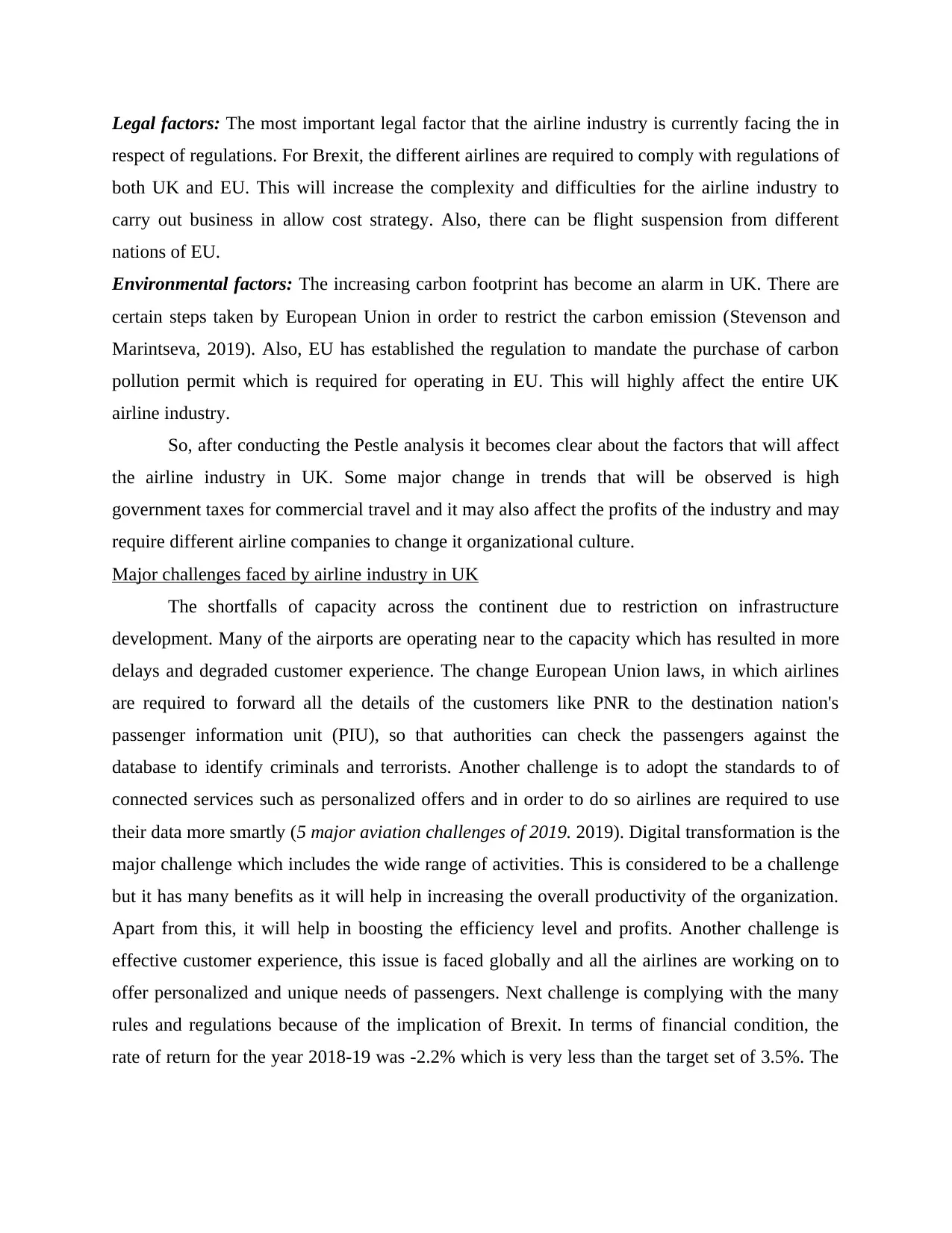
Legal factors: The most important legal factor that the airline industry is currently facing the in
respect of regulations. For Brexit, the different airlines are required to comply with regulations of
both UK and EU. This will increase the complexity and difficulties for the airline industry to
carry out business in allow cost strategy. Also, there can be flight suspension from different
nations of EU.
Environmental factors: The increasing carbon footprint has become an alarm in UK. There are
certain steps taken by European Union in order to restrict the carbon emission (Stevenson and
Marintseva, 2019). Also, EU has established the regulation to mandate the purchase of carbon
pollution permit which is required for operating in EU. This will highly affect the entire UK
airline industry.
So, after conducting the Pestle analysis it becomes clear about the factors that will affect
the airline industry in UK. Some major change in trends that will be observed is high
government taxes for commercial travel and it may also affect the profits of the industry and may
require different airline companies to change it organizational culture.
Major challenges faced by airline industry in UK
The shortfalls of capacity across the continent due to restriction on infrastructure
development. Many of the airports are operating near to the capacity which has resulted in more
delays and degraded customer experience. The change European Union laws, in which airlines
are required to forward all the details of the customers like PNR to the destination nation's
passenger information unit (PIU), so that authorities can check the passengers against the
database to identify criminals and terrorists. Another challenge is to adopt the standards to of
connected services such as personalized offers and in order to do so airlines are required to use
their data more smartly (5 major aviation challenges of 2019. 2019). Digital transformation is the
major challenge which includes the wide range of activities. This is considered to be a challenge
but it has many benefits as it will help in increasing the overall productivity of the organization.
Apart from this, it will help in boosting the efficiency level and profits. Another challenge is
effective customer experience, this issue is faced globally and all the airlines are working on to
offer personalized and unique needs of passengers. Next challenge is complying with the many
rules and regulations because of the implication of Brexit. In terms of financial condition, the
rate of return for the year 2018-19 was -2.2% which is very less than the target set of 3.5%. The
respect of regulations. For Brexit, the different airlines are required to comply with regulations of
both UK and EU. This will increase the complexity and difficulties for the airline industry to
carry out business in allow cost strategy. Also, there can be flight suspension from different
nations of EU.
Environmental factors: The increasing carbon footprint has become an alarm in UK. There are
certain steps taken by European Union in order to restrict the carbon emission (Stevenson and
Marintseva, 2019). Also, EU has established the regulation to mandate the purchase of carbon
pollution permit which is required for operating in EU. This will highly affect the entire UK
airline industry.
So, after conducting the Pestle analysis it becomes clear about the factors that will affect
the airline industry in UK. Some major change in trends that will be observed is high
government taxes for commercial travel and it may also affect the profits of the industry and may
require different airline companies to change it organizational culture.
Major challenges faced by airline industry in UK
The shortfalls of capacity across the continent due to restriction on infrastructure
development. Many of the airports are operating near to the capacity which has resulted in more
delays and degraded customer experience. The change European Union laws, in which airlines
are required to forward all the details of the customers like PNR to the destination nation's
passenger information unit (PIU), so that authorities can check the passengers against the
database to identify criminals and terrorists. Another challenge is to adopt the standards to of
connected services such as personalized offers and in order to do so airlines are required to use
their data more smartly (5 major aviation challenges of 2019. 2019). Digital transformation is the
major challenge which includes the wide range of activities. This is considered to be a challenge
but it has many benefits as it will help in increasing the overall productivity of the organization.
Apart from this, it will help in boosting the efficiency level and profits. Another challenge is
effective customer experience, this issue is faced globally and all the airlines are working on to
offer personalized and unique needs of passengers. Next challenge is complying with the many
rules and regulations because of the implication of Brexit. In terms of financial condition, the
rate of return for the year 2018-19 was -2.2% which is very less than the target set of 3.5%. The
Paraphrase This Document
Need a fresh take? Get an instant paraphrase of this document with our AI Paraphraser
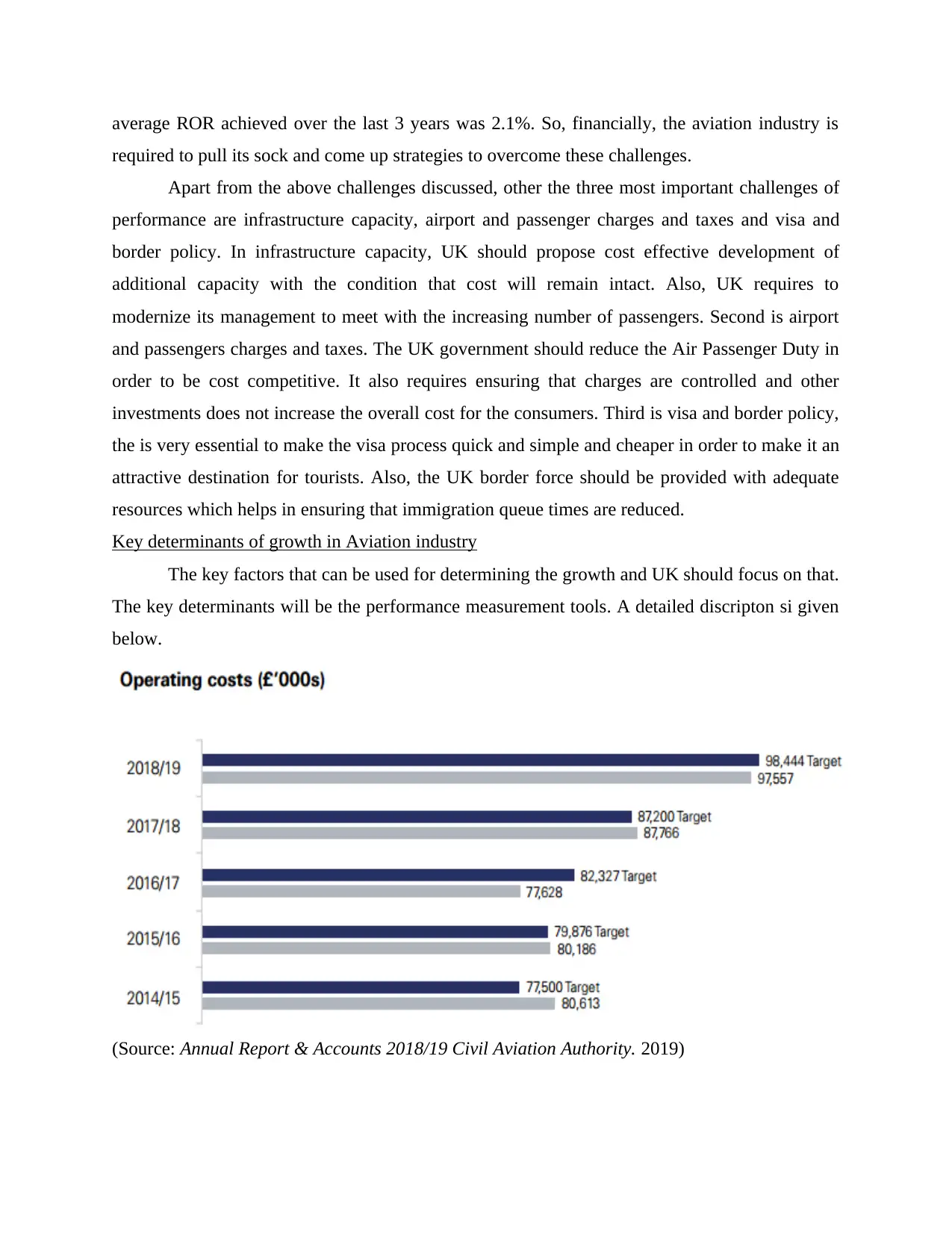
average ROR achieved over the last 3 years was 2.1%. So, financially, the aviation industry is
required to pull its sock and come up strategies to overcome these challenges.
Apart from the above challenges discussed, other the three most important challenges of
performance are infrastructure capacity, airport and passenger charges and taxes and visa and
border policy. In infrastructure capacity, UK should propose cost effective development of
additional capacity with the condition that cost will remain intact. Also, UK requires to
modernize its management to meet with the increasing number of passengers. Second is airport
and passengers charges and taxes. The UK government should reduce the Air Passenger Duty in
order to be cost competitive. It also requires ensuring that charges are controlled and other
investments does not increase the overall cost for the consumers. Third is visa and border policy,
the is very essential to make the visa process quick and simple and cheaper in order to make it an
attractive destination for tourists. Also, the UK border force should be provided with adequate
resources which helps in ensuring that immigration queue times are reduced.
Key determinants of growth in Aviation industry
The key factors that can be used for determining the growth and UK should focus on that.
The key determinants will be the performance measurement tools. A detailed discripton si given
below.
(Source: Annual Report & Accounts 2018/19 Civil Aviation Authority. 2019)
required to pull its sock and come up strategies to overcome these challenges.
Apart from the above challenges discussed, other the three most important challenges of
performance are infrastructure capacity, airport and passenger charges and taxes and visa and
border policy. In infrastructure capacity, UK should propose cost effective development of
additional capacity with the condition that cost will remain intact. Also, UK requires to
modernize its management to meet with the increasing number of passengers. Second is airport
and passengers charges and taxes. The UK government should reduce the Air Passenger Duty in
order to be cost competitive. It also requires ensuring that charges are controlled and other
investments does not increase the overall cost for the consumers. Third is visa and border policy,
the is very essential to make the visa process quick and simple and cheaper in order to make it an
attractive destination for tourists. Also, the UK border force should be provided with adequate
resources which helps in ensuring that immigration queue times are reduced.
Key determinants of growth in Aviation industry
The key factors that can be used for determining the growth and UK should focus on that.
The key determinants will be the performance measurement tools. A detailed discripton si given
below.
(Source: Annual Report & Accounts 2018/19 Civil Aviation Authority. 2019)
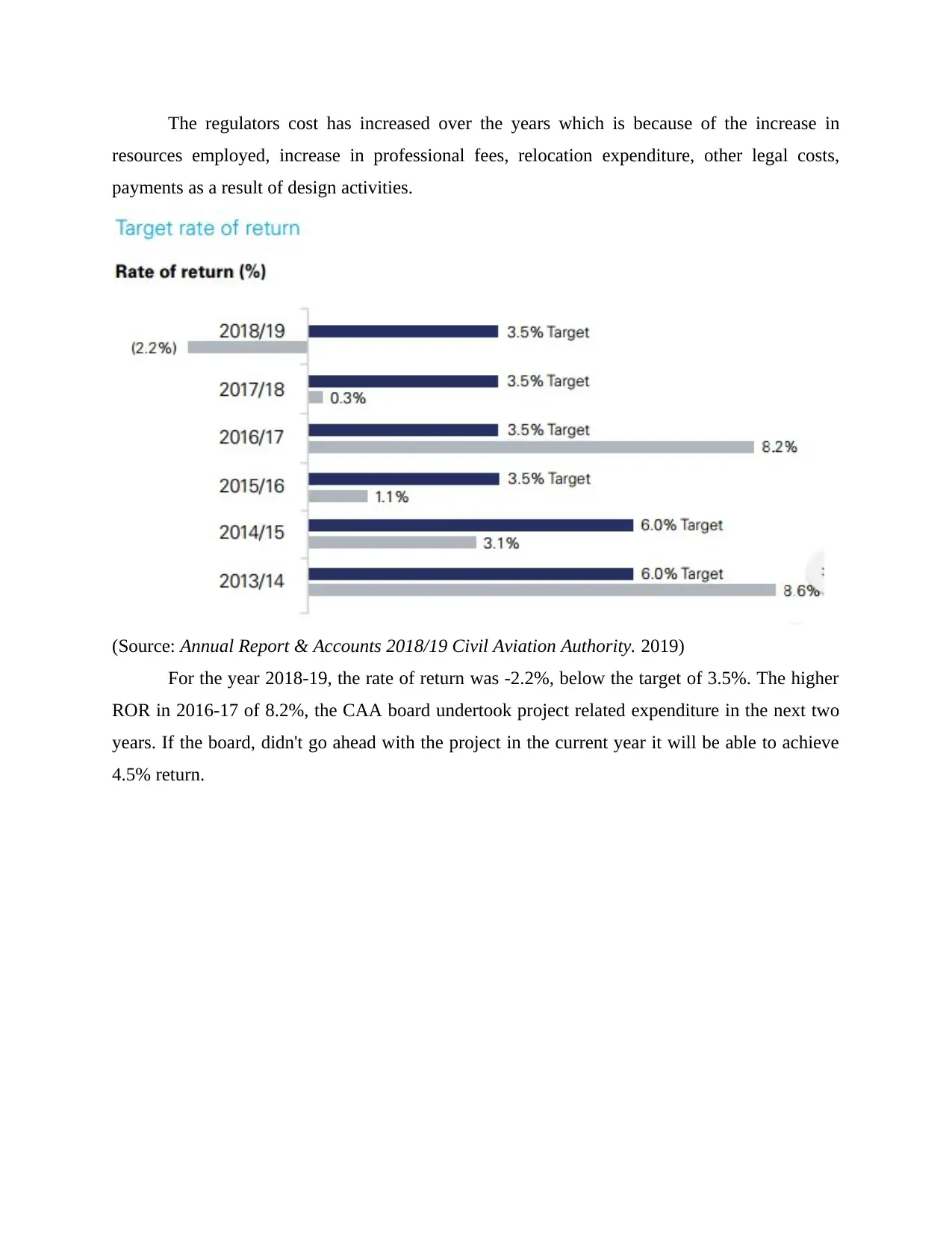
The regulators cost has increased over the years which is because of the increase in
resources employed, increase in professional fees, relocation expenditure, other legal costs,
payments as a result of design activities.
(Source: Annual Report & Accounts 2018/19 Civil Aviation Authority. 2019)
For the year 2018-19, the rate of return was -2.2%, below the target of 3.5%. The higher
ROR in 2016-17 of 8.2%, the CAA board undertook project related expenditure in the next two
years. If the board, didn't go ahead with the project in the current year it will be able to achieve
4.5% return.
resources employed, increase in professional fees, relocation expenditure, other legal costs,
payments as a result of design activities.
(Source: Annual Report & Accounts 2018/19 Civil Aviation Authority. 2019)
For the year 2018-19, the rate of return was -2.2%, below the target of 3.5%. The higher
ROR in 2016-17 of 8.2%, the CAA board undertook project related expenditure in the next two
years. If the board, didn't go ahead with the project in the current year it will be able to achieve
4.5% return.
⊘ This is a preview!⊘
Do you want full access?
Subscribe today to unlock all pages.

Trusted by 1+ million students worldwide
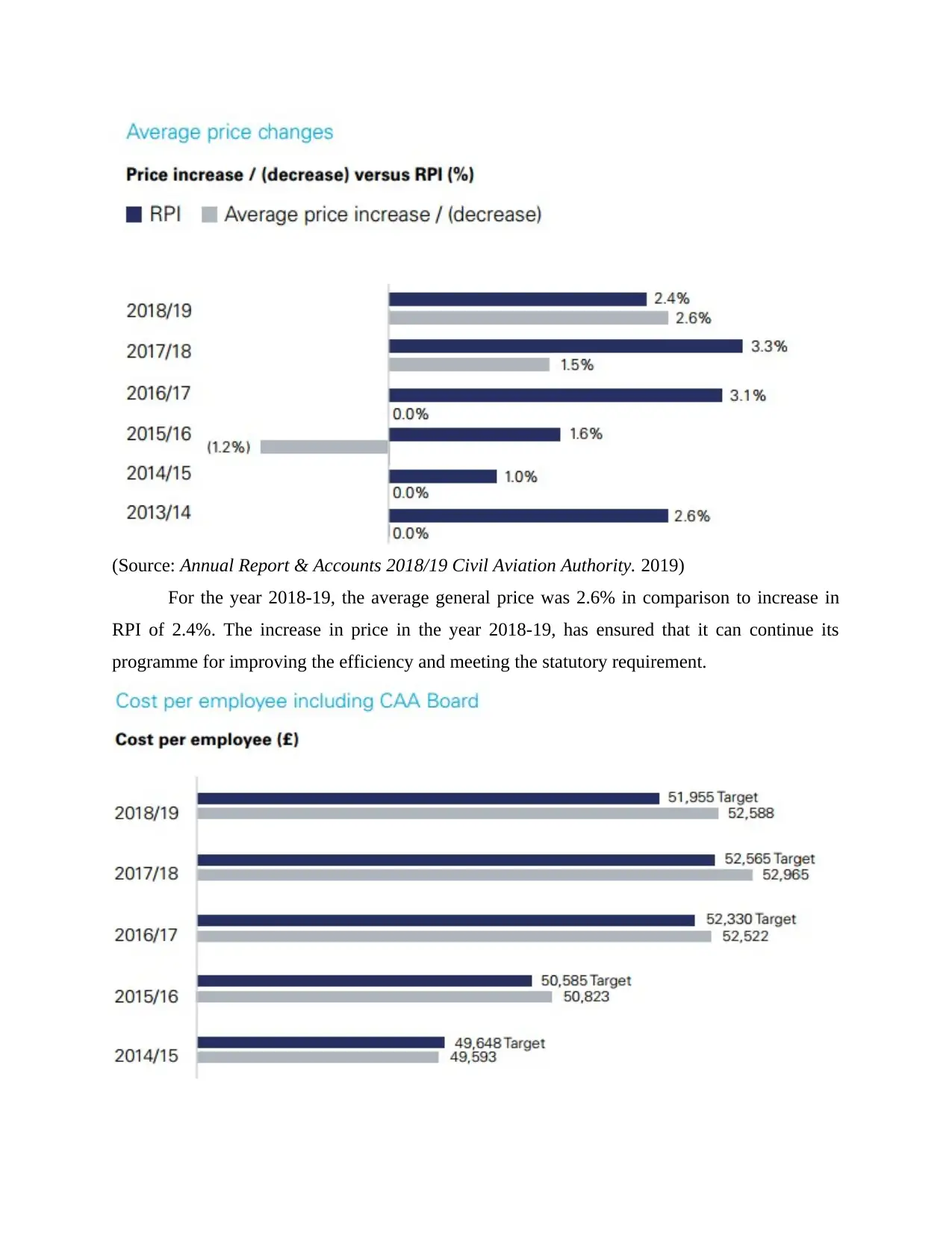
(Source: Annual Report & Accounts 2018/19 Civil Aviation Authority. 2019)
For the year 2018-19, the average general price was 2.6% in comparison to increase in
RPI of 2.4%. The increase in price in the year 2018-19, has ensured that it can continue its
programme for improving the efficiency and meeting the statutory requirement.
For the year 2018-19, the average general price was 2.6% in comparison to increase in
RPI of 2.4%. The increase in price in the year 2018-19, has ensured that it can continue its
programme for improving the efficiency and meeting the statutory requirement.
Paraphrase This Document
Need a fresh take? Get an instant paraphrase of this document with our AI Paraphraser
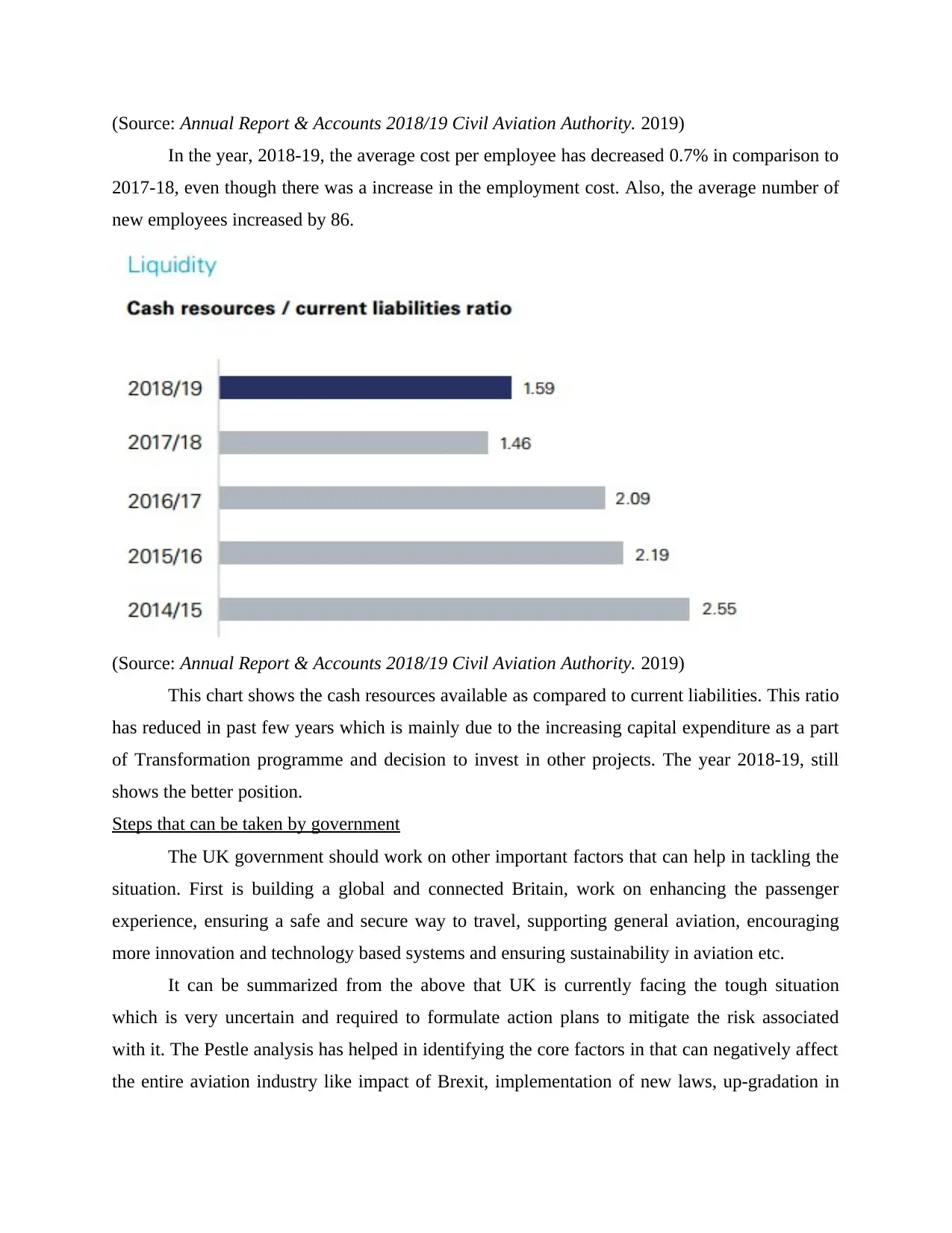
(Source: Annual Report & Accounts 2018/19 Civil Aviation Authority. 2019)
In the year, 2018-19, the average cost per employee has decreased 0.7% in comparison to
2017-18, even though there was a increase in the employment cost. Also, the average number of
new employees increased by 86.
(Source: Annual Report & Accounts 2018/19 Civil Aviation Authority. 2019)
This chart shows the cash resources available as compared to current liabilities. This ratio
has reduced in past few years which is mainly due to the increasing capital expenditure as a part
of Transformation programme and decision to invest in other projects. The year 2018-19, still
shows the better position.
Steps that can be taken by government
The UK government should work on other important factors that can help in tackling the
situation. First is building a global and connected Britain, work on enhancing the passenger
experience, ensuring a safe and secure way to travel, supporting general aviation, encouraging
more innovation and technology based systems and ensuring sustainability in aviation etc.
It can be summarized from the above that UK is currently facing the tough situation
which is very uncertain and required to formulate action plans to mitigate the risk associated
with it. The Pestle analysis has helped in identifying the core factors in that can negatively affect
the entire aviation industry like impact of Brexit, implementation of new laws, up-gradation in
In the year, 2018-19, the average cost per employee has decreased 0.7% in comparison to
2017-18, even though there was a increase in the employment cost. Also, the average number of
new employees increased by 86.
(Source: Annual Report & Accounts 2018/19 Civil Aviation Authority. 2019)
This chart shows the cash resources available as compared to current liabilities. This ratio
has reduced in past few years which is mainly due to the increasing capital expenditure as a part
of Transformation programme and decision to invest in other projects. The year 2018-19, still
shows the better position.
Steps that can be taken by government
The UK government should work on other important factors that can help in tackling the
situation. First is building a global and connected Britain, work on enhancing the passenger
experience, ensuring a safe and secure way to travel, supporting general aviation, encouraging
more innovation and technology based systems and ensuring sustainability in aviation etc.
It can be summarized from the above that UK is currently facing the tough situation
which is very uncertain and required to formulate action plans to mitigate the risk associated
with it. The Pestle analysis has helped in identifying the core factors in that can negatively affect
the entire aviation industry like impact of Brexit, implementation of new laws, up-gradation in
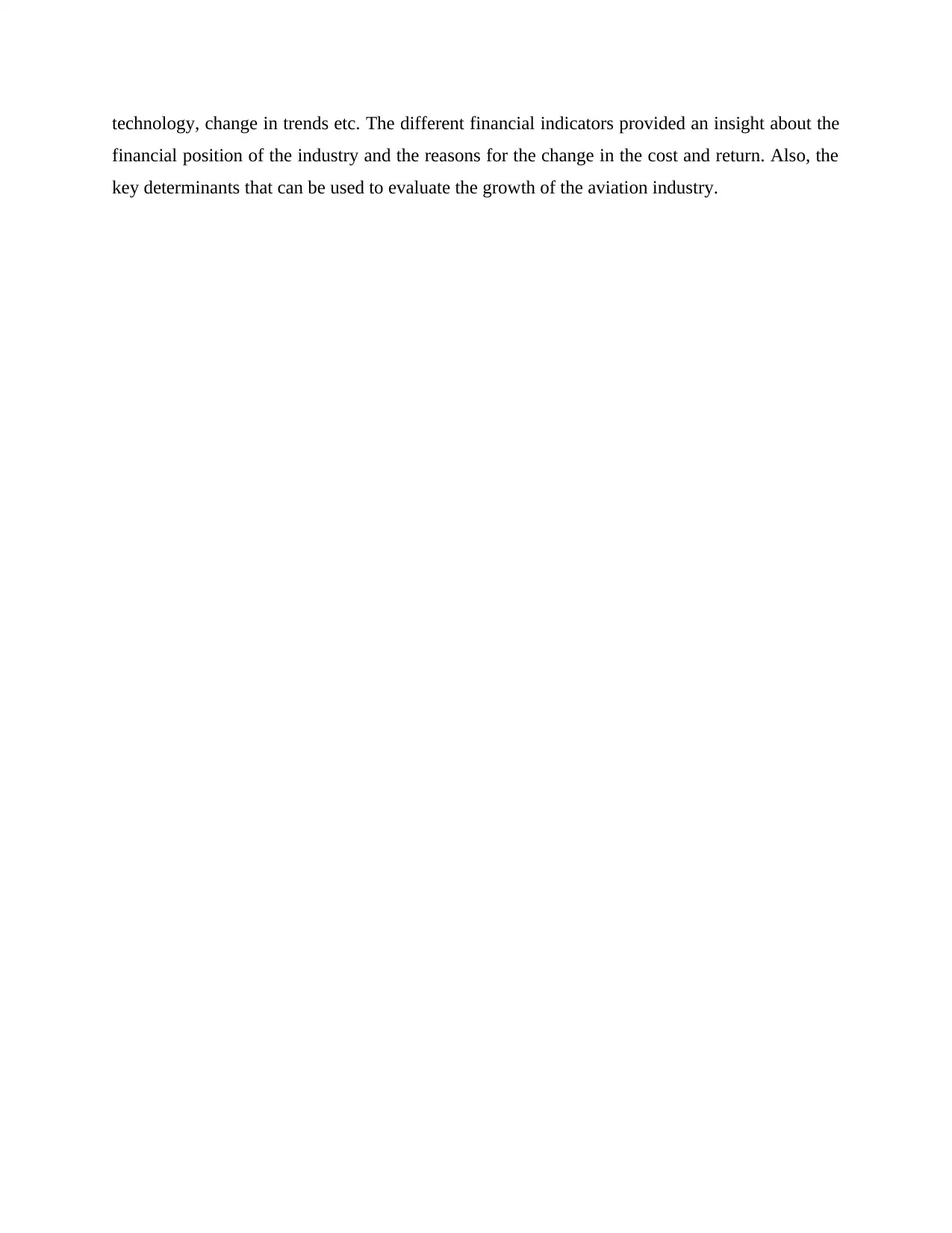
technology, change in trends etc. The different financial indicators provided an insight about the
financial position of the industry and the reasons for the change in the cost and return. Also, the
key determinants that can be used to evaluate the growth of the aviation industry.
financial position of the industry and the reasons for the change in the cost and return. Also, the
key determinants that can be used to evaluate the growth of the aviation industry.
⊘ This is a preview!⊘
Do you want full access?
Subscribe today to unlock all pages.

Trusted by 1+ million students worldwide
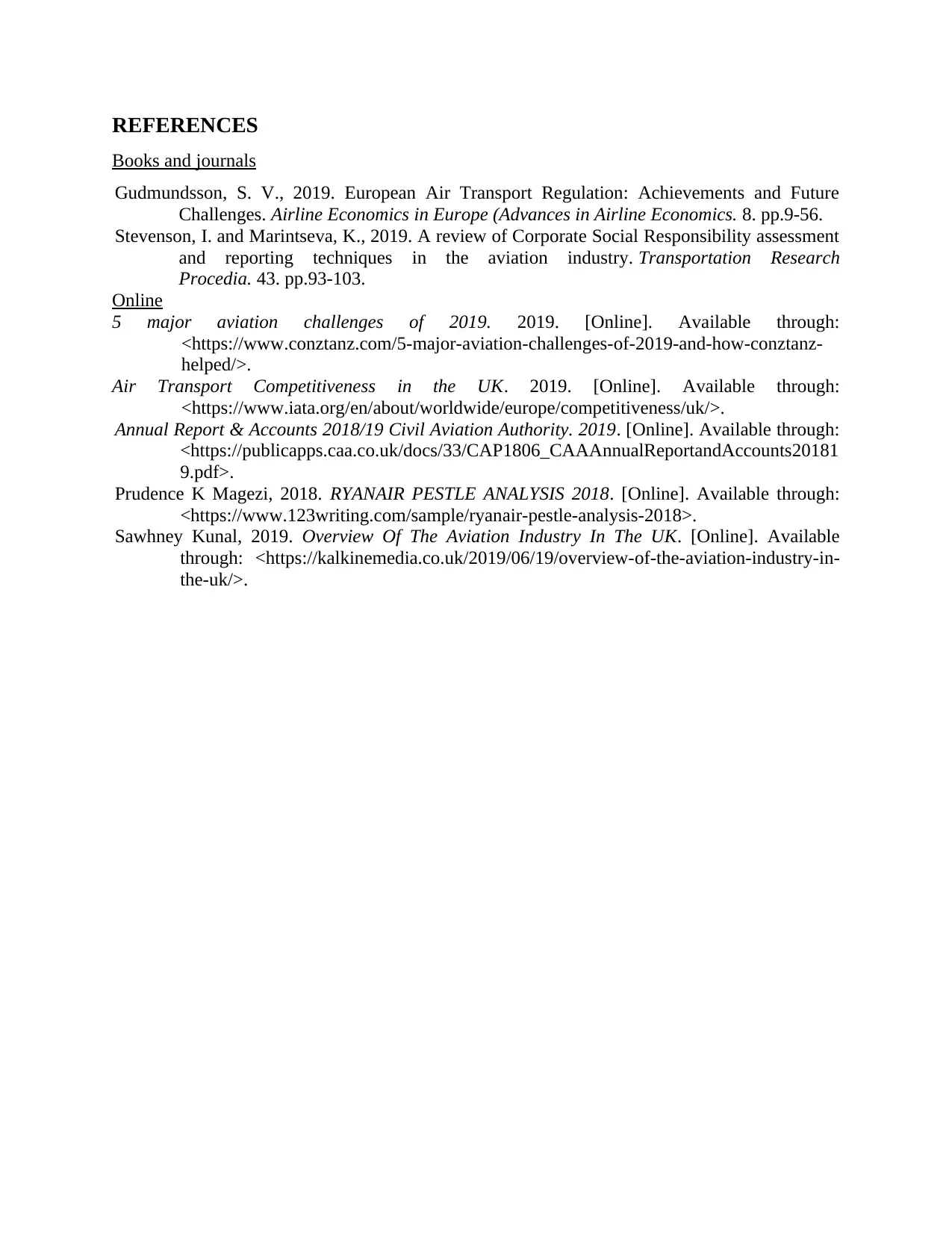
REFERENCES
Books and journals
Gudmundsson, S. V., 2019. European Air Transport Regulation: Achievements and Future
Challenges. Airline Economics in Europe (Advances in Airline Economics. 8. pp.9-56.
Stevenson, I. and Marintseva, K., 2019. A review of Corporate Social Responsibility assessment
and reporting techniques in the aviation industry. Transportation Research
Procedia. 43. pp.93-103.
Online
5 major aviation challenges of 2019. 2019. [Online]. Available through:
<https://www.conztanz.com/5-major-aviation-challenges-of-2019-and-how-conztanz-
helped/>.
Air Transport Competitiveness in the UK. 2019. [Online]. Available through:
<https://www.iata.org/en/about/worldwide/europe/competitiveness/uk/>.
Annual Report & Accounts 2018/19 Civil Aviation Authority. 2019. [Online]. Available through:
<https://publicapps.caa.co.uk/docs/33/CAP1806_CAAAnnualReportandAccounts20181
9.pdf>.
Prudence K Magezi, 2018. RYANAIR PESTLE ANALYSIS 2018. [Online]. Available through:
<https://www.123writing.com/sample/ryanair-pestle-analysis-2018>.
Sawhney Kunal, 2019. Overview Of The Aviation Industry In The UK. [Online]. Available
through: <https://kalkinemedia.co.uk/2019/06/19/overview-of-the-aviation-industry-in-
the-uk/>.
Books and journals
Gudmundsson, S. V., 2019. European Air Transport Regulation: Achievements and Future
Challenges. Airline Economics in Europe (Advances in Airline Economics. 8. pp.9-56.
Stevenson, I. and Marintseva, K., 2019. A review of Corporate Social Responsibility assessment
and reporting techniques in the aviation industry. Transportation Research
Procedia. 43. pp.93-103.
Online
5 major aviation challenges of 2019. 2019. [Online]. Available through:
<https://www.conztanz.com/5-major-aviation-challenges-of-2019-and-how-conztanz-
helped/>.
Air Transport Competitiveness in the UK. 2019. [Online]. Available through:
<https://www.iata.org/en/about/worldwide/europe/competitiveness/uk/>.
Annual Report & Accounts 2018/19 Civil Aviation Authority. 2019. [Online]. Available through:
<https://publicapps.caa.co.uk/docs/33/CAP1806_CAAAnnualReportandAccounts20181
9.pdf>.
Prudence K Magezi, 2018. RYANAIR PESTLE ANALYSIS 2018. [Online]. Available through:
<https://www.123writing.com/sample/ryanair-pestle-analysis-2018>.
Sawhney Kunal, 2019. Overview Of The Aviation Industry In The UK. [Online]. Available
through: <https://kalkinemedia.co.uk/2019/06/19/overview-of-the-aviation-industry-in-
the-uk/>.
1 out of 10
Related Documents
Your All-in-One AI-Powered Toolkit for Academic Success.
+13062052269
info@desklib.com
Available 24*7 on WhatsApp / Email
![[object Object]](/_next/static/media/star-bottom.7253800d.svg)
Unlock your academic potential
Copyright © 2020–2025 A2Z Services. All Rights Reserved. Developed and managed by ZUCOL.



